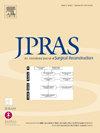Pharyngostoma reconstruction after laryngectomy and radiotherapy: A retrospective study and literature review
IF 2
3区 医学
Q2 SURGERY
Journal of Plastic Reconstructive and Aesthetic Surgery
Pub Date : 2024-10-16
DOI:10.1016/j.bjps.2024.10.019
引用次数: 0
Abstract
Background
The occurrence of pharyngocutaneous fistula or pharyngostoma after oncologic head and neck surgery is a serious complication. It is the most common complication after major hypopharyngeal and laryngeal ablative surgery.
Aim
The purpose of this study is to review the surgical approach and evaluate the results regarding reconstruction methods of pharyngostoma, caused after laryngectomy and radiotherapy.
Patients and methods
The total number of patients is 15. Pharyngostoma caused swallowing difficulties, as well as frequent aspiration pneumonia. The intervention interval from laryngectomy to pharyngeal reconstruction varied between one and three years, depending on the severity of symptoms and after the complete failure of conservative rehabilitation methods. Pharyngostoma reconstruction was performed mainly with pectoralis major myocutaneous flap in 11 cases. The radial forearm free flap and the anterolateral thigh free flap were also used in the remaining four cases.
Results
The post-operative course was uncomplicated, and in most cases, the feeding with soft food started after a barium meal between 15 and 20 days post-operatively. Complications include wound dehiscence and leak treated conservatively and one case of carotid rupture.
Conclusions
The gold standard for pharyngostoma reconstruction, after laryngectomy and cervical radiotherapy, remains the use of pectoralis major myocutaneous flap. In cases of extensive neck radionecrosis, free flaps are preferable. Reliable and stable cover of the large vessels of the neck, along with the reconstruction of the digestive tract and the restoration of swallowing function are issues that are analysed in correlation with the avoidance of stenosis and swallowing difficulties.
喉切除术和放疗后的咽喉瘤重建:回顾性研究与文献综述。
背景:头颈部肿瘤手术后出现咽瘘或咽口瘤是一种严重的并发症。目的:本研究旨在回顾喉切除术和放疗后引起的咽口瘘的手术方法,并评估重建方法的效果:患者和方法:患者总数为 15 人。咽喉瘤导致吞咽困难,并经常引发吸入性肺炎。从喉切除术到咽部重建的干预间隔时间为一到三年不等,这取决于症状的严重程度以及保守康复方法完全失败后的情况。11例患者主要使用胸大肌肌皮瓣进行咽喉重建。其余四例也使用了前臂桡侧游离皮瓣和大腿前外侧游离皮瓣:结果:术后过程并不复杂,大多数病例在术后 15-20 天服用钡餐后开始进食软食。并发症包括保守治疗的伤口裂开和渗漏,以及一例颈动脉破裂:结论:喉切除术和颈部放疗后,咽喉瘤重建的金标准仍然是使用胸大肌皮瓣。在颈部广泛放射性坏死的病例中,游离皮瓣更为可取。颈部大血管的可靠和稳定覆盖、消化道的重建以及吞咽功能的恢复,都是与避免狭窄和吞咽困难相关的问题。
本文章由计算机程序翻译,如有差异,请以英文原文为准。
求助全文
约1分钟内获得全文
求助全文
来源期刊
CiteScore
3.10
自引率
11.10%
发文量
578
审稿时长
3.5 months
期刊介绍:
JPRAS An International Journal of Surgical Reconstruction is one of the world''s leading international journals, covering all the reconstructive and aesthetic aspects of plastic surgery.
The journal presents the latest surgical procedures with audit and outcome studies of new and established techniques in plastic surgery including: cleft lip and palate and other heads and neck surgery, hand surgery, lower limb trauma, burns, skin cancer, breast surgery and aesthetic surgery.

 求助内容:
求助内容: 应助结果提醒方式:
应助结果提醒方式:


